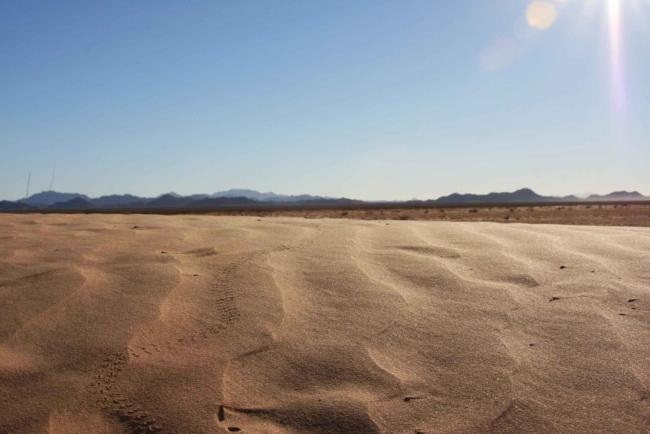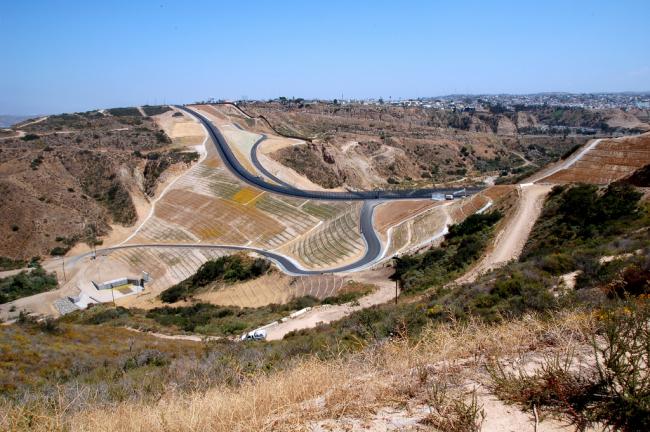
Donald Trump’s Executive Order on Border Security directs the Secretary of the Department of Homeland Security “to ensure the safety and territorial integrity of the United States” by constructing “a physical wall,” an “impassable physical barrier,” to “achieve complete operational control” of the U.S. southern border. The order frames the borderlands as yet another theater of war, a space to be secured from threats, a terrain to be cleared of any impediment to total control.
For communities living in the borderlands, this line of national defense is home, livelihood, and wellbeing. These communities are all too often assumed to be made up of people, but what of the non-human animals, plants, and other beings living and interacting with geologic and climatic processes in the U.S.-Mexico borderlands? These communities are intimately connected and interdependent. Whether or not we realize it, we humans depend on ecological communities and processes for our very existence. And, in such highly-populated areas as the U.S.-Mexico borderlands, plants, animals, and other beings rely on humans for their continued wellbeing, just as we rely on them.
And yet, much of the existing boundary enforcement regime was designed without regard for the immediate and cumulative impacts on these living and interdependent communities. When institutions such as the Department of Homeland Security (DHS) and Border Patrol deny the intimate relations between humans and other living beings, they actively ignore principles of reciprocity— our obligations as humans to care for the beings and processes that provide for us. Current scientific consensus clearly indicates that disregard for relationality and reciprocity puts all living beings at risk. As biologist Tim Keitt writes, “Loss of biological diversity can have negative impacts on the ecosystem services that are the basis of our life-support systems.”
Trump’s order to attain “complete operational control” of the southern border offers an opportunity to reflect on how the border regime implies not only controlling human bodies, but also communities of nonhuman living beings.
Landscapes along the borderlands have been subject to extensive transformation since 1994, when the Immigration and Naturalization Service initiated a new enforcement policy organized around the idea of "prevention through deterrence.” INS and Border Patrol officials believed that migrants would be deterred from crossing into the U.S. if the journey was too dangerous. Hence, the strategy aimed to shut down urban crossing points like San Diego and force aspiring migrants to consider crossing through “natural barriers,” or the rivers, mountains and desert areas in the borderlands, on the assumption the perceived risks would deter crossers. This policy had tragic consequences: according to DHS data, approximately 7,015 migrants died while crossing into the U.S. between 1998 and 2016.
A look at Operation Rio Grande, launched in 1997, reveals a poorly understood dimension of prevention through deterrence. In deterring crossings in urban areas, the strategy has pushed migrants onto public lands set aside by other branches of the federal government. The Department of the Interior (DOI) manages over 40% of lands along the southern boundary, including national parks, wildlife refuges, and forest service lands. Other public lands on the border include Tribal lands and Department of Defense lands. In other words, one branch of the federal government developed a strategy that directly affects the mission of other federal agencies.
The effect of enforcement was to push migrants into mortal danger while also endangering the wellbeing of a multitude of nonhuman beings. Operation Rio Grande was implemented in south Texas where the DOI and local environmental organizations had worked for decades to create a corridor of wildlife refuges on the banks of the Rio Grande River. The corridor encompasses nearly 90,000 acres along 275 river miles to support habitat for a multiplicity of species, eighteen of which are on the federal government’s endangered species list.
My research on the environmental dimensions of border security found that Operation Rio Grande was developed with little understanding of the federal regulations governing wildlife refuges. The Government Accountability Office had similar findings, stating the Border Patrol did not coordinate with public land managers or share their enforcement plans.
In south Texas, Border Patrol’s lack of institutional understanding and coordination led them to target the thick brush along the river’s edge, which, from their perspective, provided cover for prospective migrants. In addition to clearing the brush, the operation aimed to install surveillance cameras, ground sensors, and stadium lights. As a former assistant sector chief told me in 2005, the lights were intended to “take the darkness away from the criminal element.” The Border Patrol was not concerned about the ways brush removal or lights might affect nocturnal wildlife like the ocelot, which is listed as an endangered species. The wildlife corridor on the river’s edge is meant to protect it.
Not surprisingly, the stadium lights became a source of controversy, as Border Patrol is required to follow all federal laws. In 2000, a coalition of environmental organizations sued the Immigration and Naturalization Service (INS) on the grounds that Operation Rio Grande violated the Endangered Species Act and other federal regulations. INS settled the suit, and Border Patrol was prohibited from clearing the brush and using stadium lights until an environmental impact statement was properly completed and appropriate measures were implemented to protect the ocelot and the other parts of the ecosystem.
And yet, it has been over 15 years since the expanding boundary enforcement regime was subjected to an environmental impact review of the immediate, cumulative, and long-term effects of its policies. As required by the National Environmental Policy Act (NEPA), the Department of Justice (which then housed the INS and Border Patrol) produced an environmental impact statement of the enforcement project’s cumulative effects since 1989 and for the foreseeable future (up to 2005). The 2001 statement noted that 10,600 acres of Chihuahuan desert scrublands and Sonoran desert scrublands has been destroyed and an estimated 215,000 lizards, 6,000 birds, and 36,000 small mammals had been killed. The impacts were primarily due to the construction of thousands of miles of roads, which require destroying plant and animal communities, disrupting migration routes, and blocking hydrological systems.
Since its establishment in 2003 and absorption of the INS and its areas of responsibility, the Department of Homeland Security (DHS) has not followed up with supplemental environmental impact studies, although it is required to do so when there are substantial changes to the overall border enforcement program. And extensive changes there have certainly been.
Since 2001, the U.S. boundary enforcement regime has expanded significantly. The budget grew from $263 million in 1990 to $3.8 billion in 2015. Border Patrol agents have increased from 9.200 in 2001 to more than 20,000 in 2009. And, as of May 2015, the U.S government has built 653 miles of border fencing. Additional “tactical infrastructure” was also installed, including stadium lights, bridges, and 5,000 miles of roads.
Of the 653 miles of fencing on the southern boundary, 550 were constructed without regard for the National Environmental Policy Act, which outlines a legal framework to regulate all federal government projects. DHS was able to disregard NEPA due to language in the 2005 REAL ID Act giving the DHS Secretary authority to waive any and all laws to build border infrastructure. California Congressmen advanced the legislation after the California Coastal Commission refused to grant permission for a border wall project, which involved blocking Smuggler’s Gulch, a popular crossing point, due to environmental concerns. Between 2005 and 2008, then DHS Secretary Michael Chertoff waived more than 35 laws to build border walls and roads. With laws such as the National Environmental Policy Act, Endangered Species Act, Clean Water Act, Native American Graves Protection and Repatriation Act, American Indian Religious Freedom Act, and Eagle Protection Act waived, the current boundary enforcement regime ignores the intimate relations between humans and other living species and ecosystems.

In south Texas, where the international boundary runs through the Rio Grande, DHS faces a complex landscape. In 2007, when the Lower Rio Grande Valley National Wildlife Refuge’s manager reviewed DHS’s proposal to construct border walls at the site of the wildlife corridor, he deemed the project incompatible with the refuge’s mandate. Informed he had made a “career-ending decision,” the refuge manager retired shortly thereafter. In April 2008, DHS secretary Chertoff used his waiver authority to move forward with the project. Border walls were constructed up to two-miles north of the river in some places, while in others, walls were built into the existing levee system.
At present, the border wall affects approximately 70 percent of refuge lands in the Lower Rio Grande Valley, fragmenting the living space for wildlife; some communities are now isolated to small areas south of walls, while others are blocked from reaching the river, where they travel for water or passage south to find mates. In times of heavy rain or hurricanes (frequent occurrences in south Texas), walls block the flow of water, threatening animals who are no longer able to escape its path. In one reported case, Texas tortoises drowned on refuge land due to flooding. Cut off from their natural habitats, an increasing number of bobcats are ending up as roadkill.
In New Mexico and eastern Arizona, border infrastructure is built through the Sky Islands, a unique area where individual mountains at the northern end of the Sierra Madre Occidental peek out of the Chihuahuan and Sonoran Deserts through clouds. The changes in altitude create incredible ecological diversity. Protected areas on both the U.S. and Mexican sides of the border have allowed a profusion of wildlife to flourish. Many large animals migrate through the area to feed themselves, find water, and look for mates, including black bears, grey wolves, bighorn sheep, bison, mule deer, badgers, coatimundis, javalina, mountain lions, bobcats, ocelots, and even jaguars. The Sky Islands are already at risk due to the changing climate; drought limits water supply and causes stress for the many beings that make up this area.

In areas where vehicle barriers mark the border, animals like El Jefe, a male jaguar named by Tucson school children, are still able to migrate. However, existing walls and other enforcement infrastructure like roads and stadium lights are creating serious blockages. The problems extend far beyond the walls. Roads created to patrol the walls leave empty spaces in the landscape and crossing them makes many smaller creatures vulnerable; some species will avoid crossing at all. Although birds may appear safe from such obstacles, the impacts vary depending on the bird’s spatial behaviors and livelihood needs. For instance, Ferruginous Pygmy-Owls stay close to the ground and are unable or unlikely to fly over border walls. Trump’s proposal to build impermeable barriers puts all of these animals at risk; as individual animals struggle, their populations are at risk of extinction.
At Arizona’s southern border, over 85 percent of lands are federally owned. Here, DHS built walls at the southern end of Buenos Aires National Wildlife Refuge, Organ Pipe Cactus National Monument, Cabeza Prieta National Wildlife Refuge, and the Barry M. Goldwater Air Force Range despite the fact that federal land managers wanted vehicle barriers. In the Sonora Desert, vehicle barriers have less impact on the ecosystem because they block vehicles from driving across the border and over delicate living soil and vegetation communities, while allowing wildlife to move through the landscape. As has been repeatedly demonstrated, walls do not block people, but they do create insurmountable barriers to animals. Trapped by border walls and highways, the Sonoran Pronghorn are at the brink of extinction. Many other living beings are now enclosed in ever shrinking spaces. Sonoran Desert toads have been documented at the border wall; unable to move through, the toads die from dehydration or are killed by predators.
Walls also block the flow of water, vividly demonstrated in July 2008 when a summer storm dropped approximately two inches of rain in 90 minutes over the middle of Organ Pipe Cactus National Monument (OPCNM). The water flowed through the areas drainage systems and arrived at the 5.2-mile pedestrian fence at the OPCNM’s southern boundary on both sides of the Lukeville, Arizona Port of Entry. As predicted by OPCNM staff, the fence blocked the flow of water, despite DHS promises to the contrary. Floodwaters pooled at the fence, depositing fine sediment and debris. Floodwaters from Headquarters Wash flowed east along 200 feet of fencing and then, in an ironic twist, discharged right into the Lukeville Port of Entry, causing damage to government structures. OPCNM staff predict the fence will cause long term damage to the areas hydrological system.
In addition to building fences that block wildlife and water, DHS has literally moved mountains to build border walls. In California, Chertoff waived 36 laws to expedite construction of a border wall in the Otay Mountain Wilderness Area, east of San Diego, even though a Border Patrol spokesperson had said the infrastructure was unnecessary. Moreover, the Environmental Protection Agency objected to the project, noting that cutting roads and installing steel fencing would cause soil erosion and affect the Tijuana River’s watershed. Undeterred, DHS moved forward. The 3.6-mile segment of fencing and five-mile access road cost $57.7 million dollars and required cutting roads through wilderness, bulldozing hillsides, blasting canyons, leveling a 150-foot area on which to install the fence, and removing an estimated 530,000 cubic yards of rock.
Another major earthmoving project was at Smuggler’s Gulch; this is the project that propelled Congress to give DHS the authority to waive laws to build border barriers. Installing walls at Smuggler’s Gulch required cutting the tops off two mesas and filling a 230-foot canyon with 2 million cubic yards of dirt collected from San Diego hillsides, enough dirt to fill 72,000 dump trucks. The long-term consequences for the Tijuana Estuary are to be determined, but at risk is the wetlands capacity to nurture hundreds of species that, in turn, support human communities far beyond.

If DHS is already creating a proliferation of insecurities for lively and interdependent communities in the borderlands, what may we expect of Trump’s order for “complete operational control?” As an objective, it signals fantasies of mastery over nature, over people positioned as outsiders or even enemies. Such fantasies, argues environmental philosopher Val Plumwood, are rooted in structures of domination that position human beings as superior to nature and deny our dependency on natural processes and vulnerability to an unpredictable and changing planet.
Is complete operational control worth these risks?
Juanita Sundberg is Associate Professor of Geography and Latin American Studies at the University of British Columbia. She works at the intersection of political ecology, feminist geopolitics, critical race theory, and animal studies. Dr. Sundberg is working on a book on the nature of geopolitics in the United States-Mexico borderlands. The book draws on twelve years of research focusing on the environmental dimensions of U.S. border security in border protected areas, especially national wildlife refuges.

